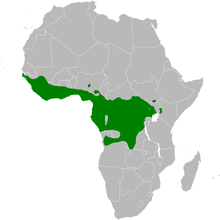Bristlebill
| Bristlebills | |
|---|---|
_(1)_(cropped).jpg) | |
| Grey-headed bristlebill (Bleda canicapillus) | |
| Scientific classification | |
| Kingdom: | Animalia |
| Phylum: | Chordata |
| Class: | Aves |
| Order: | Passeriformes |
| Family: | Pycnonotidae |
| Genus: | Bleda Bonaparte, 1857 |
| Species | |
|
3-5, see text | |
 | |
The bristlebills are a genus of passerine birds belonging to the genus Bleda in the bulbul family Pycnonotidae. They are found in the understorey of forests in West and Central Africa. They forage for insects at or near ground-level, often near water. They will follow driver ant swarms to catch prey items fleeing from the ants and they frequently join mixed-species feeding flocks.
They are 18–23 cm long with fairly long, stout bills. The upperparts are mainly green-brown while the underparts are yellow. The birds have whistling songs.
The nest is made of leaves or sticks and built in a shrub or small tree. Two eggs are laid.
Species list
- Red-tailed bristlebill, Bleda syndactylus
- Green-tailed bristlebill, Bleda eximius
- Yellow-lored bristlebill, Bleda notatus
- Yellow-eyed bristlebill, Bleda (notatus) ugandae
- Grey-headed bristlebill, Bleda canicapillus
References
- African Bird club (2006) ABC African Checklist: Passerines Accessed 31/07/07.
- Serle, W.; Morel G.J. & hartwig, W. (1977) Collins Field Guide: Birds of West Africa, HarperCollins.
- Sinclair, Ian & Ryan, Peter (2003) Birds of Africa south of the Sahara, Struik, Cape Town.
External links
| Wikispecies has information related to: Bleda |
| Wikimedia Commons has media related to Bleda (genus). |
This article is issued from Wikipedia - version of the 6/1/2016. The text is available under the Creative Commons Attribution/Share Alike but additional terms may apply for the media files.